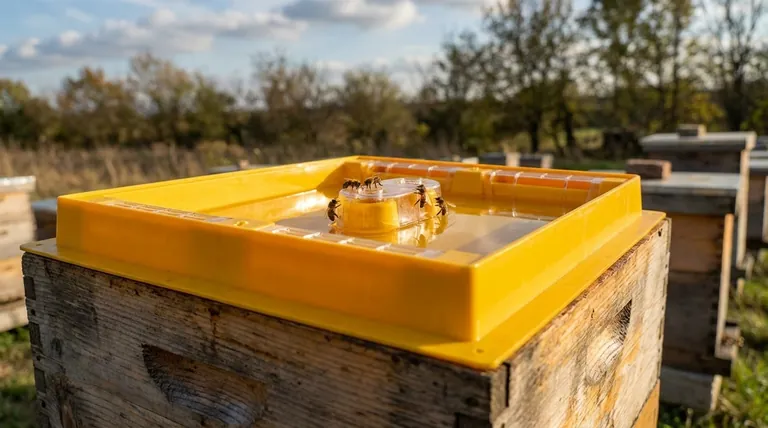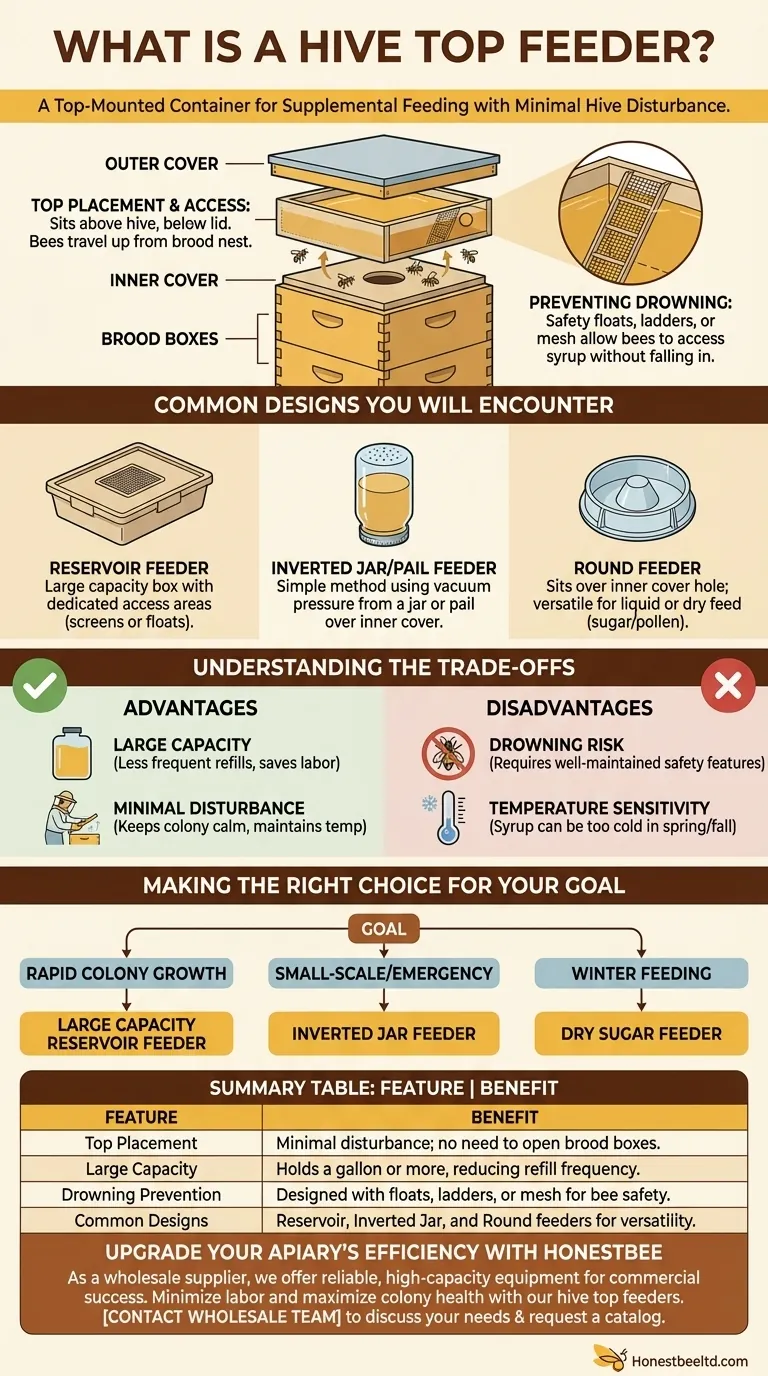In simple terms, a hive top feeder is a container placed on the very top of a beehive to provide supplemental food to the colony. It sits above the main hive boxes but underneath the outer cover, allowing a beekeeper to refill it with sugar syrup or dry feed with minimal disturbance to the bees inside.
The core advantage of a hive top feeder is its large capacity and the ability to feed a colony without fully opening the hive, which reduces stress on the bees and minimizes the risk of attracting robber bees from other colonies.

How Hive Top Feeders Work
The Core Principle: Top-Down Access
A hive top feeder is typically placed directly on the uppermost hive box, often on top of an inner cover that has a central opening. An empty hive box, or "super," is then placed around the feeder to protect it from the elements before the main hive lid is put on top.
This setup creates a protected, enclosed space for the feeder. Bees travel up from the brood nest and frames below to access the food source.
Preventing Drowning
A critical design feature of any liquid feeder is preventing the bees from drowning in the syrup. Hive top feeders solve this by providing a safe way for bees to access the liquid.
This is usually accomplished with plastic floats, ladders, or a section of wire mesh (hardware cloth) that allows bees to climb down to the syrup's surface without falling in.
Common Designs You Will Encounter
While the principle is the same, you will find a few common variations of hive top feeders.
The Reservoir Feeder
This is one of the most common types. It's essentially a shallow plastic or wooden box, often the same dimensions as a hive box, that holds a large reservoir of syrup.
These feeders have a dedicated area, frequently in the center, where bees can climb up from the hive and access the syrup via screened-off sections or floating rafts.
The Inverted Jar or Pail Feeder
This simple method uses a standard mason jar or a plastic pail. The lid is perforated with tiny holes, the container is filled with syrup, and it is quickly inverted over a hole in the hive's inner cover.
Vacuum pressure prevents the syrup from pouring out, allowing bees to drink directly from the holes in the lid.
The Round Feeder
Often made of plastic, this circular feeder sits over the hole in the inner cover. It features an inner cup or cone that bees can climb to access the syrup.
Many round feeders are also versatile enough to be used for dry feeding by simply leaving off an insert or cover, allowing you to provide dry sugar or pollen.
Understanding the Trade-offs
No piece of beekeeping equipment is perfect. Understanding the pros and cons of hive top feeders is essential for using them effectively.
Advantage: Large Capacity
Most hive top feeders can hold a gallon or more of syrup. This is a significant benefit as it reduces the frequency of refills, saving you time and labor.
Advantage: Minimal Disturbance
Refilling a hive top feeder only requires lifting the main telescoping cover. You do not need to smoke the bees or open the brood boxes, which keeps the colony calm and maintains the hive's internal temperature.
Disadvantage: Drowning Risk
Despite safety features, a poorly designed or damaged feeder can still pose a drowning risk. It is crucial to ensure floats are in place and that there are no gaps where bees can get trapped in the main syrup reservoir.
Disadvantage: Temperature Sensitivity
Because the feeder is at the top of the hive and far from the warm brood cluster, the syrup can become too cold for bees to consume in cooler weather. This makes them less effective during early spring or late fall in colder climates.
Making the Right Choice for Your Goal
The right feeder depends entirely on your colony's needs and the time of year.
- If your primary focus is rapid colony growth: A large-capacity reservoir feeder provides a consistent and abundant food source with infrequent disturbances.
- If your primary focus is small-scale or emergency feeding: An inverted jar feeder is a simple and cost-effective option for providing smaller quantities of syrup.
- If your primary focus is winter feeding: A feeder that can hold dry sugar is ideal, as it provides calories without adding the excess moisture that liquid syrup creates in cold weather.
By understanding these designs, you can effectively support your colony's nutritional needs and help them thrive throughout the year.
Summary Table:
| Feature | Benefit |
|---|---|
| Top Placement | Minimal disturbance; no need to open brood boxes. |
| Large Capacity | Holds a gallon or more, reducing refill frequency. |
| Drowning Prevention | Designed with floats, ladders, or mesh for bee safety. |
| Common Designs | Reservoir, Inverted Jar, and Round feeders for versatility. |
Upgrade Your Apiary's Efficiency with HONESTBEE
As a wholesale supplier to commercial apiaries and beekeeping equipment distributors, HONESTBEE understands that reliable, high-capacity equipment is key to your operation's success. Our hive top feeders are designed to minimize labor and maximize colony health, allowing you to focus on growth and honey production.
Let us help you equip your business with the best. Contact our wholesale team today to discuss your needs and request a catalog.
Visual Guide

Related Products
- Professional Hive Top Bee Feeder for Beekeeping
- HONESTBEE Professional Hive Top Bee Feeder Feeding Solution
- HONESTBEE Round Hive Top Bee Feeder for Syrup
- HONESTBEE Professional Entrance Bee Feeder Hive Nutrition Solution
- HONESTBEE Entrance Bee Feeder Professional Hive Nutrition Solution for Beekeeping
People Also Ask
- How to use a top feeder in a beehive? A Guide to Effective Beehive Feeding
- What types of hive boxes is the round hive top feeder compatible with? Universal Fit for 8 & 10-Frame Langstroth Hives
- Do I need an inner cover with a hive top feeder? Optimize Your Hive Setup for Healthy Bees
- What is the best bee feeder for a hive? Choose the Right Feeder for Your Apiary's Scale
- What are the advantages of hive top feeders? Maximize Feeding Efficiency for Your Apiary



















